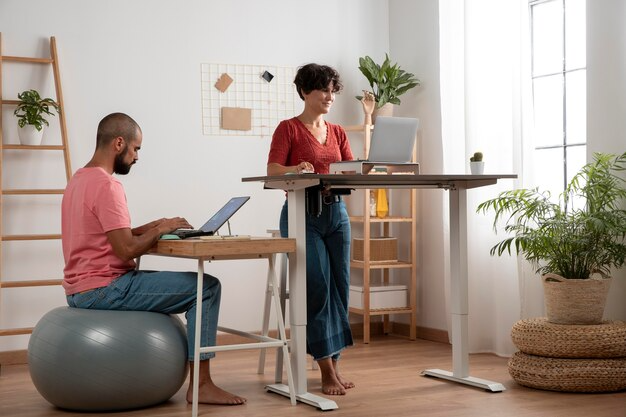
In the modern work landscape, the standing desk has emerged as a popular solution for combating the adverse effects of prolonged sitting. However, transitioning to a sit-stand work routine isn’t just about the desk itself; it’s also about finding the right office chair that complements your ergonomic needs and enhances your overall comfort. In this article, we’ll explore the world of office chairs that seamlessly integrate with standing desks, creating a harmonious and productive work environment.
Understanding the Sit-Stand Work Routine
The sit-stand work routine alternates between sitting and standing throughout the workday. This approach has gained popularity due to its potential health benefits, including improved posture, reduced risk of musculoskeletal issues, and increased energy levels. Incorporating regular standing periods into your work routine can alleviate some of the negative impacts of prolonged sitting.
The Role of Office Chairs in a Sit-Stand Work Environment
While standing desks allow you to shift between sitting and standing, it’s essential to recognize that standing for long periods can lead to discomfort and fatigue. This is where the right office chair comes into play. A well-designed chair can provide support and comfort during your sitting intervals, allowing you to maintain a balanced and comfortable work routine.
Features to Look for in Office Chairs for Sit-Stand Work
- Height Adjustment: Look for chairs with adjustable seat height. This feature ensures that your chair can be aligned with your standing desk’s height, enabling smooth transitions between sitting and standing.
- Lumbar Support: Proper lumbar support is crucial for maintaining good posture, even sitting. Choose a chair with adjustable lumbar support to cater to your unique body shape and needs.
- Seat Depth: An adjustable seat depth allows you to maintain proper leg support, whether sitting or perching on the edge of the chair while standing.
- Swivel and Mobility: Chairs with a swivel feature and smooth mobility make it easier to transition between your desk and other workspace areas.
- Tilt Mechanism: A tilt mechanism can help you maintain a comfortable sitting posture, promoting natural movement and reducing the risk of stiffness.
- Breathable Materials: Opt for chairs with breathable and comfortable upholstery materials that prevent heat buildup during extended periods of sitting.
- Armrests: Adjustable armrests can help you maintain proper wrist and forearm positioning while typing or using a mouse.
Types of Office Chairs for Sit-Stand Work Environments
- Drafting Chairs: These chairs are designed for elevated work surfaces, making them ideal for standing desks. They typically feature height-adjustable seats and footrests, allowing you to maintain a comfortable posture while seated at a higher level.
- Perching Stools: Perching stools are a versatile option for a sit-stand work routine. They allow you to perch comfortably while maintaining an upright posture, reducing the strain on your lower back.
- Active Seating Chairs: These chairs promote movement and engagement while sitting. They often have a slightly rounded or unstable base that encourages subtle signs, which can help reduce the adverse effects of prolonged sitting.
- Ergonomic Task Chairs: Some ergonomic task chairs are designed with sit-stand work in mind. They offer adjustable features and lumbar support, ensuring you stay comfortable during sitting and standing intervals.
Tips for Selecting the Right Office Chair
- Test It Out: Test the chair in person before purchasing. Sit in it for an extended period to ensure it remains comfortable and supportive over time.
- Check Adjustability: Ensure the chair’s adjustable features align with your sitting and standing preferences.
- Prioritize Comfort: Comfort is critical. Look for a chair that supports your body and minimizes discomfort while sitting and standing.
- Consider Aesthetics: Choose a chair that complements your workspace’s aesthetics while providing the necessary functionality.
- Read Reviews: Research customer reviews and testimonials to get insights into the chair’s comfort, durability, and overall performance.
- Invest in Quality: While budget considerations are important, investing in a high-quality chair will ensure it withstands the demands of a sit-stand work routine.
In Conclusion
The concept of the sit-stand work routine is grounded in the idea of promoting movement and enhancing overall well-being. The right office chair can enhance this experience by providing comfort and support during your sitting intervals. Whether you opt for a drafting chair, perching stool, active seating chair, or ergonomic task chair, prioritize adjustability, comfort, and durability. With the right chair by your side, you can embrace the benefits of a sit-stand work routine while enjoying a seamless and ergonomic workspace.





